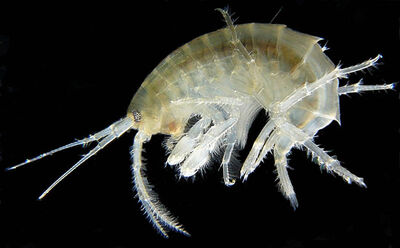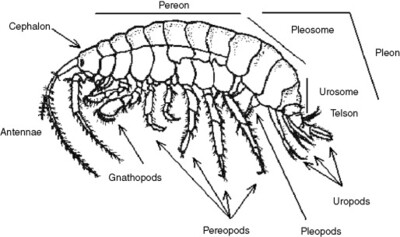Amphipods: Difference between revisions
| Line 14: | Line 14: | ||
'''Aquatic:''' Aquatic amphipods can be found in both marine and freshwater environments and are often found at the bottom of the substrate [5]. Some of the aquatic species may be seen burrowing in the substrate, creating small tunnels or depressions where they can hide from predators and forage for food [5]. In doing so, this behavior also plays a role in sediment turnover [5]. | '''Aquatic:''' Aquatic amphipods can be found in both marine and freshwater environments and are often found at the bottom of the substrate [5]. Some of the aquatic species may be seen burrowing in the substrate, creating small tunnels or depressions where they can hide from predators and forage for food [5]. In doing so, this behavior also plays a role in sediment turnover [5]. | ||
'''Terrestrial:''' Terrestrial amphipods live on the top half inch of [[soil]], relying heavily on the moisture to survive [6]. Amphipods do not contain a waxy layer on their exoskeleton, therefore they are prone to desiccation in dry environments [6]. Significant changes in soil moisture or habitat disturbance can quickly impact their populations. | '''Terrestrial:''' Terrestrial amphipods live on the top half inch of [[soil]], relying heavily on the moisture to survive [6]. Amphipods do not contain a waxy layer on their exoskeleton, therefore they are prone to desiccation in dry environments due to significant water losses[6]. Significant changes in soil moisture or habitat disturbance can quickly impact their populations. | ||
==Life Cycle== | ==Life Cycle== | ||
Most amphipod species complete their life cycle in one year or less [6]. | Most amphipod species complete their life cycle in one year or less [6]. Female amphipods can produce hundreds of eggs within a single brood [6]. These eggs are kept in a pouch called a marsupium, located on the underside of the female offering protection as the eggs develop [7]. Depending on the species and water temperature, it may take 1 to 20 weeks for the eggs to fully develop [7]. Once the eggs hatch, the juvenile amphipods look like small versions of the adults and become sexually mature after growing and molting several times [6]. | ||
==Ecosystem Importance== | ==Ecosystem Importance== | ||
Amphipods are considered secondary producers within aquatic and terrestrial food webs [8]. They primarily feed on organic materials such as [[algae]] and detritus which helps recycle nutrients [8]. Additionally, amphipods serve as a major food source for | Amphipods are considered secondary producers within aquatic and terrestrial food webs [8]. They primarily feed on organic materials such as [[algae]] and detritus which helps recycle nutrients [8]. Additionally, amphipods serve as a major food source for certain juvenile fish species [8]. | ||
==References== | ==References== | ||
Revision as of 19:56, 18 April 2025
Amphipods, are a type of crustacean which includes groups such as crabs, lobsters and shrimp [1]. Amphipods can be found in both marine and terrestrial environments with currently 10,753 known species [1]. In aquatic environments, amphipods are often referred to as as scuds, shrimp, or side swimmers [1]. On land, terrestrial species may be called land hoppers or beach/sand flies [1]. Amphipods are often considered keystone species due to their high population densities and their significant role in food webs [3].

Taxonomy
Class: Malacostraca
Subclass: Eumalacostraca
Phylum: Anthropoda
Order: Amphipoda
Family: Gammaridae

Description
Amphipods can range from 1 to 340 millimeters [2] with a laterally compressed, segmented body and prominent antennae [4]. Amphipods lack a carapace which is the hard upper shell that be seen on crayfish or lobsters [5]. Amphipoda also means "different feet", referring to their three pairs of pleopods and three pairs of uropods, whereas Isopods, a related group of crustaceans, means "same feet" [1]. Most amphipods are detritivores, feeding on decaying plant and animal matter which plays a vital role in ecosystems by breaking down organic material [5]. Similar to crayfish and lobsters, amphipods must periodically molt their exoskeleton in order to grow [6].
Habitat
Aquatic: Aquatic amphipods can be found in both marine and freshwater environments and are often found at the bottom of the substrate [5]. Some of the aquatic species may be seen burrowing in the substrate, creating small tunnels or depressions where they can hide from predators and forage for food [5]. In doing so, this behavior also plays a role in sediment turnover [5].
Terrestrial: Terrestrial amphipods live on the top half inch of soil, relying heavily on the moisture to survive [6]. Amphipods do not contain a waxy layer on their exoskeleton, therefore they are prone to desiccation in dry environments due to significant water losses[6]. Significant changes in soil moisture or habitat disturbance can quickly impact their populations.
Life Cycle
Most amphipod species complete their life cycle in one year or less [6]. Female amphipods can produce hundreds of eggs within a single brood [6]. These eggs are kept in a pouch called a marsupium, located on the underside of the female offering protection as the eggs develop [7]. Depending on the species and water temperature, it may take 1 to 20 weeks for the eggs to fully develop [7]. Once the eggs hatch, the juvenile amphipods look like small versions of the adults and become sexually mature after growing and molting several times [6].
Ecosystem Importance
Amphipods are considered secondary producers within aquatic and terrestrial food webs [8]. They primarily feed on organic materials such as algae and detritus which helps recycle nutrients [8]. Additionally, amphipods serve as a major food source for certain juvenile fish species [8].
References
[1] Horton, T., Lowry, J., De Broyer, C., Bellan-Santini, D., Coleman, C. O., Daneliya, M., ... & Zeidler, W. (n.d.). World Amphipoda Database. World Register of Marine Species. https://www.marinespecies.org/amphipoda/#:~:text=The%20order%20Amphipoda%20is%20part,and%20three%20pairs%20of%20uropods.
[2] iNaturalist. (n.d.). Amphipoda. https://www.inaturalist.org/taxa/47628-Amphipoda
[3] Eawag. (2023, October 3). Amphipods: A miraculous increase in biodiversity. https://www.eawag.ch/en/info/portal/news/news-detail/amphipods-a-miraculous-increase-in-biodiversity/
[4] ScienceDirect. (n.d.). Amphipod. Elsevier. https://www.sciencedirect.com/topics/earth-and-planetary-sciences/amphipod
[5] Missouri Department of Conservation. (n.d.). Scuds, sideswimmers (amphipods). https://mdc.mo.gov/discover-nature/field-guide/scuds-sideswimmers-amphipods#:~:text=Habitat%20and%20Conservation,at%20the%20bottom%20of%20ponds.
[6] Buss, L. W., & Bextine, B. (2009). Amphipods (Publication No. IN377). University of Florida IFAS Extension. https://edis.ifas.ufl.edu/publication/IN377
[7] ScienceDirect. (n.d.). Amphipoda. Elsevier. https://www.sciencedirect.com/topics/agricultural-and-biological-sciences/amphipoda
[8] ScienceDirect. (n.d.). Amphipod. Elsevier. https://www.sciencedirect.com/science/article/pii/S002209812300117X
[9] Hudson River Park Trust. (n.d.). Amphipod. https://hudsonriverpark.org/the-park/parks-river-project/science/wetlab/invertebrates/amphipod/